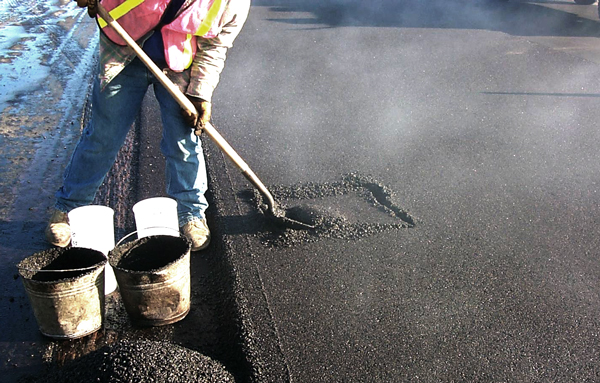Hot Mix Asphalt Paving: Redefining Commercial Property Landscapes
Wiki Article
Unlocking the Secrets of Hot Mix Asphalt Technology
Discovering the midsts of hot mix asphalt innovation discovers a globe where exact formulas and careful processes assemble to form our roadways and facilities. The combination of aggregates, binders, and fillers isn't just a building task yet a calculated orchestration of resilience and efficiency. As we peer right into the intricate dancing of components, a tapestry of durability and sustainability unravels. What lies under this surface of asphaltic proficiency, and what keys wait to be revealed in the realm of paving developments?Value of Warm Mix Asphalt
Hot Mix Asphalt plays an important role in modern-day facilities growth due to its resilience and cost-effectiveness. As the most frequently used leading product for roadways, freeways, and parking whole lots, Warm Mix Asphalt offers a range of benefits that add to its value in construction jobs.The durability of Hot Mix Asphalt stems from its make-up, which consists of accumulations, binder, and filler materials that are very carefully selected and blended to satisfy particular performance needs. Generally, the importance of Hot Mix Asphalt in facilities development can not be underrated, as it continues to be a cornerstone of modern-day building and construction practices.
Elements of Asphalt Mixes
The composition of asphalt blends consists of carefully chosen aggregates, binder, and filler products that are vital for accomplishing specific efficiency requirements. Aggregates are the primary part of asphalt blends, supplying toughness and security. The binder, commonly asphalt or asphalt cement, holds the accumulations together and offers flexibility and longevity to the mix.The mix and percentage of these components play a substantial function in identifying the high quality and efficiency of the asphalt mix. Engineers carefully develop the mix to fulfill specific demands, thinking about factors like website traffic quantity, environment problems, and sidewalk lifespan. Proper choice and balancing of accumulations, binder, and fillers are vital for producing durable, lasting asphalt pavements.
Mixing and Production Techniques

As soon as the accumulations are chosen, the binder, usually asphalt cement, is contributed to bind the materials together. The binder's top quality and quantity significantly impact the mix's stamina, resistance, and flexibility to ecological aspects. Furthermore, fillers like moisturized lime or Rose city concrete may be integrated to improve details features of the asphalt mix, such as its workability or moisture resistance.
During manufacturing, the aggregates and binder are heated, normally between 250-325 ° F(121-163 ° C ), to promote mixing and ensure proper finish of the accumulations. The blending procedure should be detailed to achieve an uniform mixture that promotes the desired efficiency attributes of the asphalt. Various techniques, such as batch mixing or drum blending, are employed to achieve high-grade and regular asphalt blends for building and construction jobs.
Aspects Impacting Asphalt Performance
Factors affecting asphalt performance incorporate a series of variables that impact the durability, long life, and general top quality of asphalt find here pavements. One crucial factor is the top quality of materials used in the asphalt mix. The type and source of accumulations, the binder high quality, and the ingredients all play a significant function in establishing the efficiency of the asphalt sidewalk. The gradation of aggregates is critical as it impacts the mix's workability, stability, and resistance to cracking and rutting.
Layout considerations, such as pavement sites density and drain, are essential in making sure the lasting performance of the asphalt sidewalk. By meticulously thinking about these designers, contractors and variables can enhance asphalt efficiency and boost the solution life of sidewalks.
Lasting Practices in Asphalt Modern Technology

Additionally, the advancement of warm-mix asphalt (WMA) modern technologies has acquired traction in the last few years. WMA permits the manufacturing and positioning of asphalt mixes at lower temperature levels contrasted to traditional hot-mix asphalt, leading to lowered power consumption and greenhouse gas discharges. The usage of porous asphalt visit the website mixes can assist mitigate stormwater drainage problems by permitting water to penetrate through the sidewalk and into the ground, advertising natural water purification and recharge processes. By applying these sustainable methods, the asphalt market can add to constructing a more eco-friendly and resilient framework network.
Verdict
Finally, warm mix asphalt modern technology plays a crucial role in contemporary facilities advancement as a result of its durability and cost-effectiveness. By thoroughly balancing components, utilizing appropriate mixing methods, and thinking about different aspects, engineers can produce premium asphalt blends that stand up to heavy web traffic tons and severe weather condition problems. Welcoming lasting methods, such as utilizing recycled materials and warm-mix technologies, better boosts the ecological friendliness of asphalt technology.
Mixing and manufacturing methods in hot mix asphalt technology entail the exact combination and handling of accumulations, binder, and fillers to create a durable and high-performance asphalt mix.Variables influencing asphalt performance incorporate a variety of variables that impact the longevity, long life, and general quality of asphalt sidewalks. Sustainable techniques in asphalt innovation encompass different initiatives intended at decreasing the environmental effect of asphalt production and paving procedures. By incorporating redeemed asphalt pavement (RAP) and recycled asphalt tiles (RAS) into brand-new asphalt mixes, the sector can considerably reduce the usage of raw products and energy, while additionally reducing land fill waste.
WMA enables for the manufacturing and placement of asphalt blends at reduced temperatures contrasted to conventional hot-mix asphalt, resulting in lowered energy usage and greenhouse gas exhausts.
Report this wiki page